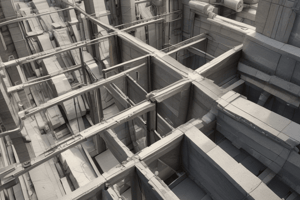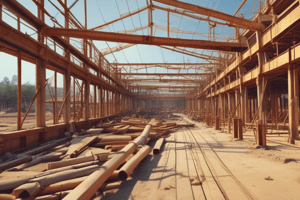Podcast
Questions and Answers
Which type of pile is typically used for displacement?
Which type of pile is typically used for displacement?
- Steel H Pile (correct)
- Wooden Pile
- Barrettes
- Concrete Pile
What is the primary benefit of using the Wet Joint method in precast construction?
What is the primary benefit of using the Wet Joint method in precast construction?
- It requires less labor to install.
- It improves water tightness through in-situ concrete. (correct)
- It reduces construction time.
- It enhances the aesthetic appearance.
Which formwork can be removed the fastest after construction?
Which formwork can be removed the fastest after construction?
- Slabs
- Columns
- Walls (correct)
- Beams
Which type of pump is NOT used for dewatering operations?
Which type of pump is NOT used for dewatering operations?
What is added to concrete to make it self-compacting?
What is added to concrete to make it self-compacting?
What construction equipment is specifically designed to lift materials such as wall tiles to elevated floors?
What construction equipment is specifically designed to lift materials such as wall tiles to elevated floors?
What steel components are primarily used in a Simply Supported Beam?
What steel components are primarily used in a Simply Supported Beam?
At what temperature (~°C) does a structure typically lose half of its strength?
At what temperature (~°C) does a structure typically lose half of its strength?
What is the most effective and economical system used in curtain wall construction?
What is the most effective and economical system used in curtain wall construction?
Which one of the following materials is not typically used in cover spaces?
Which one of the following materials is not typically used in cover spaces?
Which type of pile is predominantly used in Hong Kong for displacement?
Which type of pile is predominantly used in Hong Kong for displacement?
What is one of the main risks associated with building basements?
What is one of the main risks associated with building basements?
Which method is recommended for deeper basements exceeding 20 meters?
Which method is recommended for deeper basements exceeding 20 meters?
Which type of test is commonly performed to assess the quality of piles?
Which type of test is commonly performed to assess the quality of piles?
What is one of the advantages of using precast concrete?
What is one of the advantages of using precast concrete?
What machine is typically used for bored pile installation?
What machine is typically used for bored pile installation?
What is one of the key advantages of using U-shaped pre-tension beams on a construction site?
What is one of the key advantages of using U-shaped pre-tension beams on a construction site?
Which factor is essential when determining the site plan for prefabrication?
Which factor is essential when determining the site plan for prefabrication?
What is the primary purpose of predrilling in pile installation?
What is the primary purpose of predrilling in pile installation?
What device is typically used to push the temporary steel casing into the ground?
What device is typically used to push the temporary steel casing into the ground?
What is the depth requirement for the bellout formed at the base of the borehole?
What is the depth requirement for the bellout formed at the base of the borehole?
How is the excavated soil handled during the boring process?
How is the excavated soil handled during the boring process?
What alternative method may be used to bore through rock when installing piles?
What alternative method may be used to bore through rock when installing piles?
Which machinery is crucial for the compaction process during prefabrication?
Which machinery is crucial for the compaction process during prefabrication?
What is the purpose of casting vertical elements horizontally during troweling?
What is the purpose of casting vertical elements horizontally during troweling?
Which of the following statements about precast components is true?
Which of the following statements about precast components is true?
How does using a waterproofing layer in precast toilets contribute to construction efficiency?
How does using a waterproofing layer in precast toilets contribute to construction efficiency?
What is a significant environmental benefit of factory production compared to site production?
What is a significant environmental benefit of factory production compared to site production?
What is the impact of prestressed concrete on building design?
What is the impact of prestressed concrete on building design?
Why is it beneficial to fix external finishes at ground level?
Why is it beneficial to fix external finishes at ground level?
Which aspect of precast construction addresses potential labor shortages?
Which aspect of precast construction addresses potential labor shortages?
What is a key advantage of minimizing the number of separate operations in construction?
What is a key advantage of minimizing the number of separate operations in construction?
What is the purpose of immersing the tip of the tremie pipe about 1 metre below concrete level during the construction process?
What is the purpose of immersing the tip of the tremie pipe about 1 metre below concrete level during the construction process?
Which of the following steps occurs immediately after the concrete hardens in the top-down construction method?
Which of the following steps occurs immediately after the concrete hardens in the top-down construction method?
What role do the steel stanchions play in the construction of a top-down method?
What role do the steel stanchions play in the construction of a top-down method?
In what order are the excavation and construction processes performed in the top-down construction method?
In what order are the excavation and construction processes performed in the top-down construction method?
What is the primary function of the temporary openings made in the slabs during the construction process?
What is the primary function of the temporary openings made in the slabs during the construction process?
What is the primary purpose of using spacers in reinforcement during concrete pouring?
What is the primary purpose of using spacers in reinforcement during concrete pouring?
Why is the tremie pipe placed at a depth of 2 m to 3 m below the concrete surface?
Why is the tremie pipe placed at a depth of 2 m to 3 m below the concrete surface?
What role does bentonite slurry play during the excavation of a diaphragm wall?
What role does bentonite slurry play during the excavation of a diaphragm wall?
What is a benefit of using treated bentonite in the excavation process?
What is a benefit of using treated bentonite in the excavation process?
What is the purpose of placing vertical tubes (stop-ends) at each end of the excavation panel?
What is the purpose of placing vertical tubes (stop-ends) at each end of the excavation panel?
Which of the following is NOT a function of the guide walls constructed for diaphragm wall excavations?
Which of the following is NOT a function of the guide walls constructed for diaphragm wall excavations?
What structural component is formed by embedding the exposed reinforcement after the concrete has cured?
What structural component is formed by embedding the exposed reinforcement after the concrete has cured?
What is a typical panel width for excavation in stable soil when constructing a diaphragm wall?
What is a typical panel width for excavation in stable soil when constructing a diaphragm wall?
Flashcards
Displacement Pile
Displacement Pile
Steel H piles are driven into the ground to displace soil, providing support for structures.
Replacement Pile
Replacement Pile
Barrettes are drilled into the ground and concrete is poured in, replacing the excavated soil.
Tremie Pipes
Tremie Pipes
Using tremie pipes prevents contaminated concrete by ensuring a continuous flow of concrete and preventing air from entering the mix.
Self-compacting Concrete
Self-compacting Concrete
Signup and view all the flashcards
Superplasticizers
Superplasticizers
Signup and view all the flashcards
Fly Form/Table Form
Fly Form/Table Form
Signup and view all the flashcards
Continuous Beam
Continuous Beam
Signup and view all the flashcards
Simply Supported Beam
Simply Supported Beam
Signup and view all the flashcards
Water Tightness Jointing
Water Tightness Jointing
Signup and view all the flashcards
Unitised Curtain Wall System
Unitised Curtain Wall System
Signup and view all the flashcards
Top-Down Construction
Top-Down Construction
Signup and view all the flashcards
Diaphragm Wall
Diaphragm Wall
Signup and view all the flashcards
Advantages of Precast Concrete
Advantages of Precast Concrete
Signup and view all the flashcards
Basement Construction Risks
Basement Construction Risks
Signup and view all the flashcards
Cofferdam
Cofferdam
Signup and view all the flashcards
Troweling
Troweling
Signup and view all the flashcards
Precast Toilet
Precast Toilet
Signup and view all the flashcards
Reduced Operations
Reduced Operations
Signup and view all the flashcards
Continuity of Operation
Continuity of Operation
Signup and view all the flashcards
Faster Construction
Faster Construction
Signup and view all the flashcards
Environmentally Friendly
Environmentally Friendly
Signup and view all the flashcards
Prestressed Concrete
Prestressed Concrete
Signup and view all the flashcards
Pre-tensioning
Pre-tensioning
Signup and view all the flashcards
Bored Pile
Bored Pile
Signup and view all the flashcards
Tremie Pipe Method
Tremie Pipe Method
Signup and view all the flashcards
Temporary Steel Casing
Temporary Steel Casing
Signup and view all the flashcards
Bellout Formation
Bellout Formation
Signup and view all the flashcards
Bentonite Slurry
Bentonite Slurry
Signup and view all the flashcards
Stop-End
Stop-End
Signup and view all the flashcards
Stop-End Recess
Stop-End Recess
Signup and view all the flashcards
Soil Removal
Soil Removal
Signup and view all the flashcards
Foundation Slab
Foundation Slab
Signup and view all the flashcards
What are the benefits of using prefabricated components on a construction project?
What are the benefits of using prefabricated components on a construction project?
Signup and view all the flashcards
What are U-shaped pre-tension beams?
What are U-shaped pre-tension beams?
Signup and view all the flashcards
What is the concept of prefabrication in construction?
What is the concept of prefabrication in construction?
Signup and view all the flashcards
When planning for prefabrication, what is a crucial factor to consider about the site's crane?
When planning for prefabrication, what is a crucial factor to consider about the site's crane?
Signup and view all the flashcards
What is the importance of storage space in prefabrication?
What is the importance of storage space in prefabrication?
Signup and view all the flashcards
Before employing prefabrication, what aspect of the site's internal layout is essential to review?
Before employing prefabrication, what aspect of the site's internal layout is essential to review?
Signup and view all the flashcards
Describe the basic steps involved in installing machine-dug piles.
Describe the basic steps involved in installing machine-dug piles.
Signup and view all the flashcards
Why is the temporary steel casing essential in the machine-dug pile installation?
Why is the temporary steel casing essential in the machine-dug pile installation?
Signup and view all the flashcards
Study Notes
Pile Types
- Two main pile types exist: displacement piles (steel H piles) and replacement piles (barrettes).
Tremie Pipe Advantages
- Tremie pipes prevent concrete contamination.
Formwork Removal Priority
- Walls and columns can be removed first because they support themselves.
- Beams and slabs require more time for removal due to weaker horizontal support.
Dewatering Pumps
- Submerged pumps and suction pumps are used for dewatering.
Self-Compacting Concrete
- Self-compacting concrete is highly workable and pumpable.
Concrete Additives for Self-Compacting Concrete
- Superplasticizers are added to concrete to make it self-compacting (pumpable and flowable).
Formwork for Tall Buildings
- Fly Form/Table Form is a suitable formwork for speeding up slab construction in tall buildings.
Continuous Beam Steel
- Top steel (cantilever) and bottom steel (span) are used for continuous beams.
- Additionally, steel is required over several spans of RC beams.
Simply Supported Beam Steel
- For single spans, the main reinforcement steel is bottom steel.
Joint Types for Precast Concrete
- Wet joints (Monolithic joints) using in-situ concrete topping are better for preventing water leakage issues than dry joints (sealant/gasket) due to complete gap coverage.
Silent Construction Equipment
- Hydraulic vibrator machines are notable for quieter operation.
Fire Damage Threshold
- Concrete and steel structures lose half their strength at 600°C.
Wall Tile Moving Machinery
- Material hoists are used for moving wall tiles.
Watertight Joints
- Silicone is best for watertight joints in various construction applications.
- Epoxy is better for concrete spalling or structural repair.
Covering Materials
- Plastic is a common material used for cover spaces in construction.
Curtain Wall Systems
- Unitised systems are the most effective and cost-efficient.
Popular Displacement Pile in Hong Kong
- Steel H Piles are the most prevalent.
Bored Pile Installation
- Bored pile installation requires temporary steel casing, hydraulic oscillators, chisels, RCD with roller bits, underway marks, steel reinforcement cages, and tremie pipes.
Pile Tests
- Common pile tests include dynamic load tests, static load tests, sonic load tests, sonic logging tests, standard penetration tests, core drilling, vibration tests, lateral load tests, and tension tests.
Top-Down Construction Advantages
- Top-down construction minimizes construction time because basement and superstructure can be constructed simultaneously.
- Weather conditions are favorable.
Deep Basement Construction Methods
- For basements exceeding 20 meters in depth, diaphragm walls are preferred in tandem with a top-down construction process.
- Basement construction up to 10–20 meters deep typically utilizes steel sheet piling, and cofferdams.
Basement Building Risks
- Soil collapse, worker safety, underground utility disruption, neighboring structure settlement, and groundwater issues are primary concerns during basement construction.
Precast Concrete Advantages
- Skilled labor demands are lower in precast constructions due to consistent quality control in factory settings.
- Construction costs are potentially lower and environmental aspects are improved.
- Indoor working, using robots, and better compaction are possible.
Precast Construction Considerations
- Window frames are cast before concreting for better water leakage control.
- Waterproofing layers are used within prefabricated sections for improved leakage prevention.
Precast Concrete Construction Benefits in Reducing Labor Demands
- External finishes are fixed at ground level to avoid scaffolds, reducing labor on site.
- Precast construction eliminates separate trades, streamlining site workflow.
- Production operates consistently, irrespective of weather conditions.
- Precast elements ensure timely product supply.
- Construction time is shortened, and labor-related issues are limited.
Precast Production Advantages
- Waste in material use is reduced in factory production.
- Quality of completed work is improved, reducing rework needs and minimizing future repairs.
- Noises, and fumes are confined to factory areas, thus improving the overall environment.
- Replacing timber formwork further enhances the process.
Prefabrication on Site Plan Considerations
- Ensure that the tower crane can handle the necessary materials.
- Provide suitable storage space with appropriate dimensions.
- Decide on the most efficient materials handling system based on the speed and frequency of the consumption of pre-fabricated materials within the construction process.
- Ensure that the internal site access can handle any construction vehicles.
Machine Dug Pile Installation
- Predrilling is essential for pile placement directly unto the rock surface.
- Soil investigation determines the appropriate place for the pile.
- Vibratory hammers or oscillators are used to position and install the casing.
- Rotary augers or other drilling bits are used to bore the initial holes.
- The casing is connected for extension in the drilling process.
- If the pile is founded on rock, RCD (reversed circulation drill) can be used.
- Reinforcement cages, tremie pipes, and concrete are put in place for filling.
- The casing can be removed from the boring hole after sufficient concrete strength.
Diaphragm Wall Procedures
- Guide walls and hydrofraise/hydromill tools create trenches.
- Bentonite slurry helps during excavation because it prevents soil collapse.
- The soil needs recirulation and is pumped from the trench while excavation is ongoing.
- Tubes (stop ends) are used to create a semicircular recess for construction joints.
Top-down Construction Process
- Diaphragm walls are built.
- Bored holes and stanchions are used in the top-down construction approach.
- Ground floor slabs are constructed as the upper portions are exposed and ready.
- After constructing the ground floor, the excavation for subsequent levels can begin, while the building's superstructure is constructed simultaneously.
- Excavation work leads to beam and slab systems supporting the wall.
- Removal of debris is carried out as the process progresses.
Studying That Suits You
Use AI to generate personalized quizzes and flashcards to suit your learning preferences.




